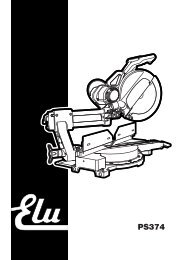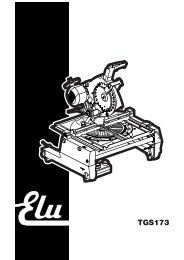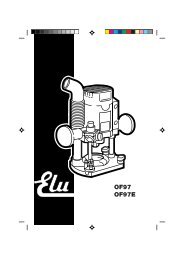Instruction Manual (English) - Service - Dewalt.no
Instruction Manual (English) - Service - Dewalt.no
Instruction Manual (English) - Service - Dewalt.no
You also want an ePaper? Increase the reach of your titles
YUMPU automatically turns print PDFs into web optimized ePapers that Google loves.
ENGLISHSafety <strong>Instruction</strong>sWARNING! When using electric tools basic safety precautionsshould always be followed to reducethe risk of fire, electric shock and personal injuryincluding the following.Read all these instructions before attempting to operate this product andsave these instructions.SAVE THIS MANUAL FOR FUTURE REFERENCEGeneral Safety Rules1. Keep work area clear.Cluttered areas and benches invite injuries.2. Consider work area environment.Do <strong>no</strong>t expose the tool to rain. Do <strong>no</strong>t use the tool in damp or wetconditions. Keep the work area well lit (250 - 300 Lux). Do <strong>no</strong>t usethe tool where there is a risk of causing fire or explosion, e.g., in thepresence of flammable liquids and gases.3. Guard against electric shock.Avoid body contact with earthed surfaces (e.g., pipes, radiators,cookers and refrigerators). When using the tool under extremeconditions (e.g., high humidity, when metal swarf is being produced,etc.), electric safety can be improved by inserting an isolatingtransformer or a (FI) earth-leakage circuit-breaker.4. Keep other persons away.Do <strong>no</strong>t let persons, especially children, <strong>no</strong>t involved in the work, touchthe tool or the extension cord and keep them away from the work area.5. Store idle tools.When <strong>no</strong>t in use, tools must be stored in a dry place and locked upsecurely, out of reach of children.6. Do <strong>no</strong>t force the tool.It will do the job better and safer at the rate to which it was intended.7. Use the right tool.Do <strong>no</strong>t force small tools to do the job of a heavy duty tool. Do <strong>no</strong>t usetools for purposes <strong>no</strong>t intended; for example do <strong>no</strong>t use circular sawsto cut tree limbs or logs.8. Dress properly.Do <strong>no</strong>t wear loose clothing or jewellery, as these can be caught inmoving parts. Non-skid footwear is recommended when workingoutdoors. Wear protective hair covering to contain long hair.9. Use protective equipment.Always use safety glasses. Use a face or dust mask if workingoperations create dust or flying particles. If these particles might beconsiderably hot, also wear a heat-resistant apron. Wear ear protectionat all times. Wear a safety helmet at all times.10. Connect dust extraction equipment.If devices are provided for the connection of dust extraction andcollecting equipment, ensure these are connected and properly used.11. Do <strong>no</strong>t abuse the cord.Never yank the cord to disconnect it from the socket. Keep thecord away from heat, oil and sharp edges. Never carry the tool by itscord.12. Secure work.Where possible use clamps or a vice to hold the work. It is safer thanusing your hand and it frees both hands to operate the tool.13. Do <strong>no</strong>t overreach.Keep proper footing and balance at all times.14. Maintain tools with care.Keep cutting tools sharp and clean for better and safer performance.Follow instructions for lubricating and changing accessories. Inspecttools periodically and if damaged have them repaired by an authorizedservice facility. Keep handles and switches dry, clean and free from oiland grease.15. Disconnect tools.When <strong>no</strong>t in use, before servicing and when changing accessories suchas blades, bits and cutters, disconnect tools from the power supply.16. Remove adjusting keys and wrenches.Form the habit of checking to see that adjusting keys and wrenches areremoved from the tool before operating the tool.17. Avoid unintentional starting.Do <strong>no</strong>t carry the tool with a finger on the switch. Be sure that the tool isin the “off” position before plugging in.18. Use outdoor extension leads.Before use, inspect the extension cable and replace if damaged.When the tool is used outdoors, use only extension cords intended foroutdoor use and marked accordingly.19. Stay alert.Watch what you are doing. Use common sense. Do <strong>no</strong>t operate the toolwhen you are tired or under the influence of drugs or alcohol.20. Check for damaged parts.Before use, carefully check the tool and mains cable to determinethat it will operate properly and perform its intended function. Checkfor alignment of moving parts, binding of moving parts, breakage ofparts, mounting and any other conditions that may affect its operation.A guard or other part that is damaged should be properly repaired orreplaced by an authorized service centre unless otherwise indicatedin this instruction manual. Have defective switches replaced by anauthorized service centre.Do <strong>no</strong>t use the tool if the switch does <strong>no</strong>t turn it on and off.Never attempt any repairs yourself.WARNING! The use of any accessory or attachment orperformance of any operation with this tool other than thoserecommended in this instruction manual may present a risk ofpersonal injury.21. Have your tool repaired by a qualified person.This electric tool complies relevant safety rules. Repairs should only becarried out by qualified persons using original spare parts; otherwise thismay result in considerable danger to the user.Additional safety rules for mitre saws• Make sure all locking k<strong>no</strong>bs and clamp handles are tight before startingany operation.• Ensure that the machine arm is securely fixed when performing bevelcuts.• Do <strong>no</strong>t operate the machine without the guard in position, or if theguard does <strong>no</strong>t function or is <strong>no</strong>t maintained properly.• Never place either hand in the blade area when the saw is connected tothe electrical power source.• Never attempt to stop a machine in motion rapidly by jamming a tool orother means against the blade; serious accidents can occur.• Select the correct blade for the material to be cut.• Wear suitable gloves when handling saw blade and rough materials.• Never perform any cleaning or maintenance work when the machine isstill running and the head is <strong>no</strong>t in the rest position.• The front section of the guard is louvred for visibility while cutting.Although the louvres dramatically reduce flying debris, there areopenings in the guard and safety glasses should be worn at all timeswhen viewing through the louvres.• Never cut workpiece shorter than 200 mm.• Without additional support the machine is designed to accept themaximum workpiece size of:– Height 63 mm by width 205 mm by length 500 mm– Longer workpieces need to be supported by suitable additionaltable, e.g. DE3474. Always clamp the workpiece safely.• During use in mitre saw mode ensure that the portion of the saw blade,below the table, is completely enclosed by the guard (63) shown inFig. E.Additional safety rules for saw benches• Make sure that the blade rotates in the correct direction and the teethare pointing to the front of the saw bench.• Make sure all locking k<strong>no</strong>bs and clamp handles are tight before startingany operation.15
















